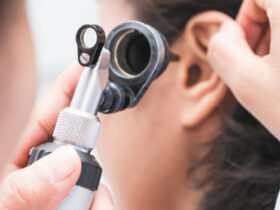By Svetlana Kogan, M.D.
 People ask: I get awful sinus headaches in the fall and winter. They are so bad that decongestants don’t help. Why?
People ask: I get awful sinus headaches in the fall and winter. They are so bad that decongestants don’t help. Why?
Dr.Kogan answers: There is a good chance the medications are not helping because sinus trouble is not the source of your pain. In one recent study of 2,991 adults who thought they had sinus headaches, 88% actually had migraines. The confusion is understandable. During a migraine, the trigeminal nerve (one of the brain’s pathways for migraine-related pain signals) fires overtime. This can also cause congestion. And incidence of migraines peaks in the fall – the shorter, darker days can result in serotonin dips, which can cause blood vessels to swell. Fortunately, 5-HTP, an amino acid that converts to serotonin, may help. Typically, 50mg taken once daily, is highly effective in reducing frequency and severity of migraines. I like 5-HTP by Douglas Labs or Biotics Research. Both vegetarian and No-GMO – available here: https://us.fullscript.com/welcome/skogan In addition to 5-HTP, try organic Feverfew extract by Herb Pharm, one full squeeze of the dropper bulb, dissolved in 2 oz of water 3 times /day. Also available at the above link.
People ask: I battled a nasty cold last week, and now there is a protruding pea-sized lump in the front of my neck. It does not hurt, but it does seem to be getting bigger. Should I just chalk it up to swollen glands from being sick?
Dr.Kogan answers: While swollen lymph nodes can be triggered by the common cold, they generally occur on either side of the neck, under the jaw, or behind ears. Plus they are tender and usually remain swollen only for as long as a virus lasts. On the other hand, a lump located on the throat that does not cause pain is likely a thyroid nodule. This type of of solid or fluid-filled lump affects an estimated 10-15% of general population. There are various underlying causes of nodules, including iodine deficiency, an autoimmune condition called Hashimoto’s thyroiditis, or rarely even thyroid cancer. The great news is that more than 95% of thyroid nodules are totally benign and have zero malignant potential.
It is important to see your primary care physician, who can determine the cause of your nodule with a physical exam, ultrasound, and blood tests. Most benign nodules will dissipate on their own but your doctor may recommend specific lifestyle and dietary changes to hasten this recovery.
People ask: While doing some mindless exercises at my desk, I noticed a lump the size of nickel on my wrist. It is sore to the touch, and it seems to bulge even more after a long day of typing. I am a little freaked out – what is this thing?
Dr.Kogan answers: Don’t worry: this sounds like a ganglion cyst, a harmless lump that grows out of a capsule of the joint or from the sheath of a tendon, similar to balloon on a stalk. Ganglion cysts are very common, especially in women, and often occur when repetitive exercises (like typing) cause the tissue surrounding the joint to bulge out of place. As you’ve noticed, the more active the joint, the larger the cyst often becomes. Your doctor can confirm the diagnosis with a physical exam. He or she may recommend wearing a thin wrist brace like an elastic ACE bandage for a few weeks to curb unnecessary movement of the wrist. You can still type while wearing it, but try to rest your wrist as much as possible. Also smart: using ergonomic keyboard setup at work, which will also minimize strain on the wrist. If these measures fail to shrink the cyst within three weeks, your doctor may be able to drain it or refer you for low frequency pulsed electromagnetic wave therapy.
People ask: Exercising in my target heart rate zone exhausts me. I thought I was in shape. Why is it so difficult?
Dr.Kogan answers: Don’t feel disappointed in your stamina – you may just be pushing yourself too hard. Researchers at Northwestern College of Medicine in Chicago reveal that heart rate monitors (like those often used in conjunction with programmable treadmills) are likely to be inaccurate because they were programmed using an outdated formula. This results in a target number that is too high for many women, leading them to exhaustion. The good news: The researchers devised a new formula for determining target heart rate. Calculate 220 minus your age, and multiply the difference by 80%. So, for a 45 year old person, the target heart rate range is (220-45) X80% = 140 bpm. So you want to be somewhere around that number. But since it is tough to take your pulse while exercising, here is an easier gauge: If you can carry on a conversation, you are likely in the low –to middle range of your target. If you are breathing too hard to talk, you may be working too hard. If you slow your pace and still tire easily – then see your doctor. She or he will look at your lifestyle (poor sleep and eating habits can cause breathlessness even in athletes), and possibly run tests to check lung capacity and cardiovascular health.
Svetlana Kogan, M.D. is a Board Certified Medical Doctor with 20 years of experience. She has appeared as a health expert on FOX, ABC, CBS, and NBC prime time TV, and has authored hundreds of publications for internet and print. She just moved her Concierge Internal
Medicine practice from Manhattan NYC to Naples, where her focus is on fusing traditional medicine with holistic approach to illness and prevention.
Svetlana Kogan, M.D.
Board Certified Medical Doctor
720 Fifth Ave S, Unit 209
Naples , FL 34102
Phone: (239) 676-6883
www.customlongevity.com










